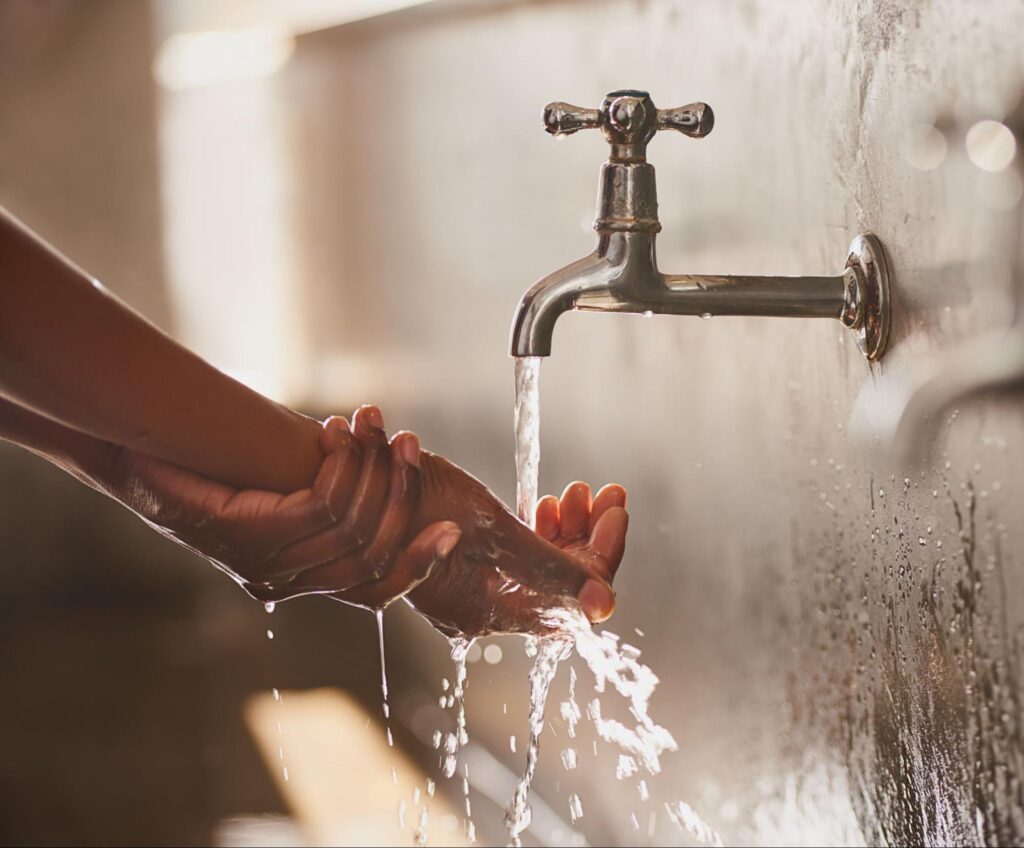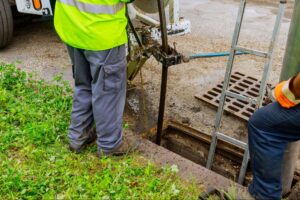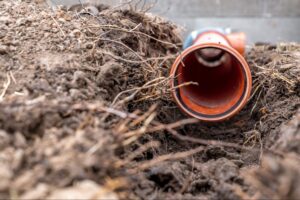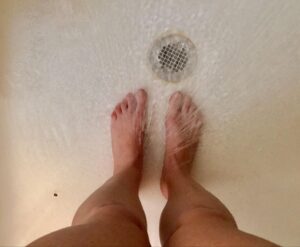Imagine turning on your tap expecting clean water, only to find it potentially polluted with contaminants. Water is one of our most essential resources, relied upon daily for drinking, cooking, cleaning, and sanitation. Yet, this basic need can be compromised by an often-overlooked issue called backflow—the reverse flow of water in a plumbing system that allows harmful pollutants and other substances to infiltrate a clean water supply.
Backflow frequently happens during sudden changes in water pressure, such as pipe bursts. This can draw contaminants from yards, sewers, or industrial areas backward into otherwise safe water lines. The consequences can range from minor health issues to large-scale environmental hazards. Heightened awareness of backflow prevention is crucial for protecting both individual properties and the broader public water supply.
What Are Backflow Preventers and How Do They Work?
Think of your plumbing system as a one-way street where water flows exclusively from the public supply (or a private well) to your fixtures. A backflow event reverses this direction, allowing unwanted contaminants to enter your water lines. A properly installed backflow preventer is the barrier that stops that reverse movement, ensuring water only moves forward.
Backflow can occur under two primary conditions:
Backpressure
When internal system pressure (for example, from a boiler or pressurized system) becomes higher than the incoming water supply’s pressure, water—and any pollutants within it—are pushed back into the main supply line. This scenario is more common in industrial or commercial settings where high-pressure machinery is used.
Backsiphonage
A sudden drop in water pressure in the main supply line creates a vacuum effect that pulls contaminants into cleaner water lines. For instance, during a major firefighting operation, a city might open several hydrants simultaneously, decreasing main line pressure and inadvertently siphoning contaminants back into the system.
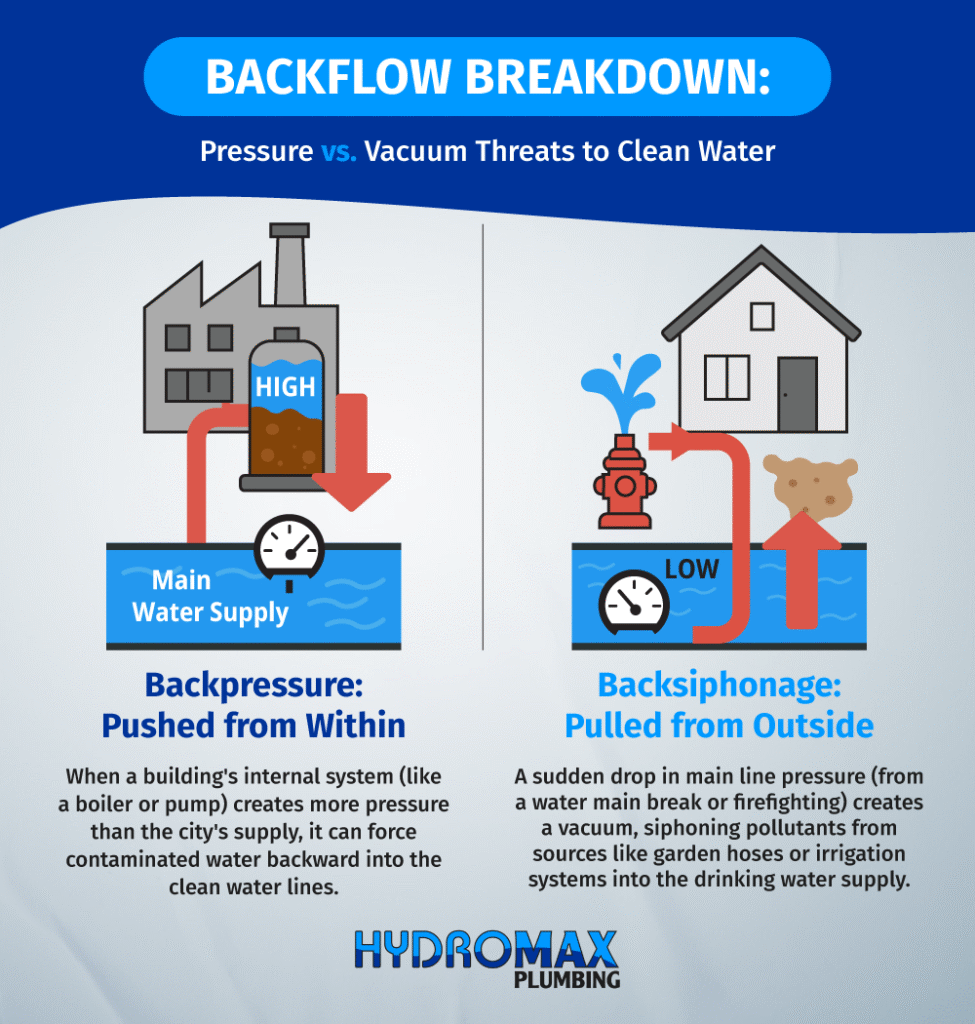
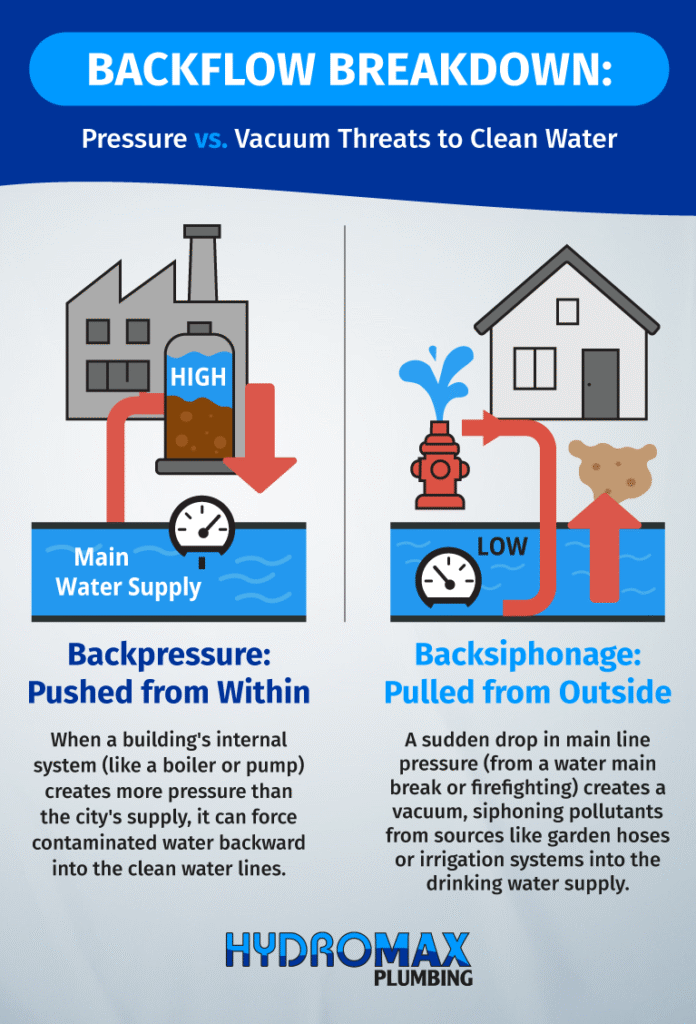
Typical devices—such as an Atmospheric Vacuum Breaker (AVB), a Double Check Valve (DCV), or a Reduced Pressure Zone Assembly (RPZ)—are designed for different risk levels. When installed by trained professionals and maintained regularly, they create a robust shield against backflow incidents.
In Evansville, as well as many other regions, local ordinances frequently require backflow preventers if a building uses irrigation systems, fire suppression systems, or advanced commercial appliances. The logic is simple: better protection for one building or facility translates to better protection for the entire community. With yearly inspections often mandated, these devices have become a cornerstone of modern plumbing infrastructure.
The High Cost of Contamination: Why Backflow Prevention is Essential
Clean water is fundamental to daily life, but a single backflow event can introduce everything from mild irritants to dangerous pathogens into the supply. Backflow preventers serve as a critical shield, bolstering public health and building community trust by keeping drinking water systems pure.
The consequences of contamination extend beyond immediate health risks, carrying significant financial repercussions for all sectors:
- Residential: Homeowners gain peace of mind knowing their family can use water safely. Prevention helps them avoid the steep costs of replacing damaged appliances, sanitizing contaminated water heaters, and extensive plumbing repairs.
- Commercial: In workplaces, a safe water supply is vital for a healthy environment. A backflow incident can lead to serious business interruptions and liabilities if customers or employees are exposed to compromised water.
- Industrial: For facilities with complex piping systems where clean water is integral to production, contamination can halt operations, spoil products, and trigger massive financial losses.
Furthermore, regulatory bodies often mandate backflow prevention devices, and non-compliance can result in costly fines and legal action. Ultimately, investing in prevention is far more cost-effective than dealing with the aftermath of a contamination event, saving individuals, businesses, and municipalities from the expense of remediation, lawsuits, and emergency cleanups.
Key Signs of Backflow Problems
Many backflow incidents remain undetected until substantial damage has occurred. Being watchful for certain indicators can help property owners and managers catch issues early. Look out for:
- A strange taste or odor in your water
- Discoloration that suggests sediment or rust
- Unexplained drops in water pressure
- Leaks or unexplained puddles near plumbing fixtures
- Alarms triggered by monitoring systems
Real-world incidents highlight the importance of vigilance. In some cases, undetected backflow events have allowed contaminants to gradually spread through a system, so that by the time changes in taste, odor, or color are noticed, a broader portion of a facility’s water system may be affected. Early detection and regular maintenance are key to preventing more extensive issues and reducing the need for major cleanup efforts.
Backflow Prevention Across Various Settings
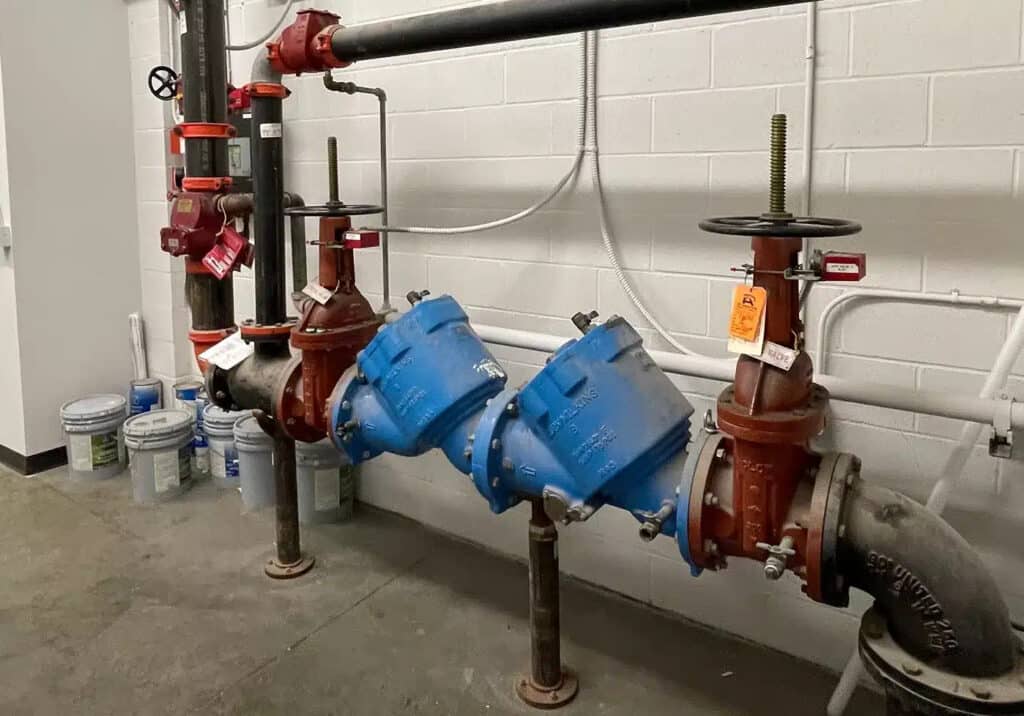
While the main goal—preventing contamination—remains the same, each environment can present its own challenges and vulnerabilities. Tailored solutions ensure that backflow prevention devices meet the demands of diverse operations:
- Residential Plumbing: Even a simple scenario—like using a garden hose with a fertilizer attachment—can create a high-risk situation if backflow occurs. If water pressure suddenly changes, those chemicals could flow into the household’s pipes or even the municipal water supply. Homeowners often rely on straightforward devices but must keep them in working order to remain effective.
- Commercial Plumbing: Offices, restaurants, hospitals, and retailers often have extensive water usage and more complex fixtures. A restaurant’s kitchen equipment, such as dishwashers or carbonated beverage dispensers, can significantly change water flow. Additionally, properties like hotels or shopping centers often require multiple layers of backflow prevention due to the volume and variety of water-using appliances.
- Industrial Facilities: In these environments, high-pressure systems and chemical processes are common. A backflow event could compromise water lines as well as manufactured products, resulting in substantial financial losses. Industrial-grade backflow devices, capable of handling extreme pressure differentials, often need more frequent inspections and specialized maintenance.
- Municipal Systems: Large-scale backflow prevention programs are critical for protecting a city’s or town’s overall water supply. Municipalities work in tandem with local businesses and homeowners to ensure compliance. Robust inspections and systematic oversight help uphold water quality for entire populations.
How to Maintain Backflow Prevention Systems Effectively
Even the most reliable equipment requires proactive upkeep. Over time, mineral buildup, shifting water pressures, and environmental changes can reduce a device’s effectiveness. In many parts of the country, annual testing and certification are more than just a recommendation—they’re required by law. Here are essential steps to ensure your backflow prevention system is always ready:
- Schedule Routine Inspections: Many local codes call for yearly tests by certified professionals to confirm that prevention devices remain operational and valves remain properly aligned.
- Monitor Water Pressure: Sudden fluctuations in water pressure can strain or dislodge internal components, making them prone to leaks or partial failure.
- Prevent Freeze Damage: In colder climates, insulate exposed pipes and prevent water from stagnating. Frozen water expands, cracking the internal components of backflow devices.
- Flush the System Regularly: Flush out sediment and small debris that can accumulate. This step often coincides with routine plumbing maintenance.
- Repair Leaks Promptly: Even a minor leak can worsen over time, reducing device performance and creating an entry point for contaminants.
- Recordkeeping: Document all testing, maintenance, and any device replacements. Having a clear record helps you meet regulatory obligations and can accelerate repairs in the future.
Keep in mind that maintenance isn’t limited to the device alone. For example, poorly maintained irrigation systems can introduce debris into your plumbing lines, increasing the risk of a backflow event. Similarly, ignoring the health of your drains can lead to debris accumulation that pressures backflow preventers from the opposite side. A comprehensive prevention strategy thus involves the entire water delivery and drainage ecosystem.
Local codes in Evansville often follow state and federal guidelines, such as drinking water regulations set by the EPA. Property owners have a responsibility to remain aware of changing requirements, ensuring that their devices continue to meet or exceed standards. Working with professional plumbers who understand local regulations can save countless headaches and keep systems fully compliant.
The Advantages of Professional Backflow Preventer Services
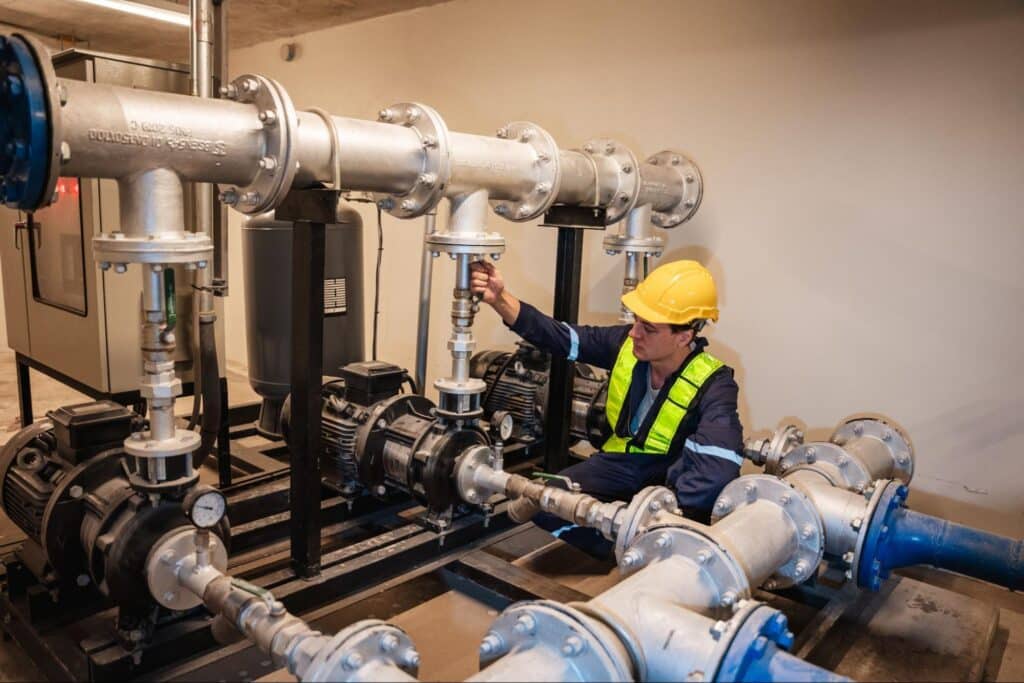
Partnering with certified plumbers for backflow preventer testing, installation, and maintenance comes with invaluable benefits:
- Compliance with industry standards and local regulations, avoiding costly fines and unsafe conditions.
- Protection of public health through rigorous defense against contamination.
- Proactive testing and maintenance strategies that mitigate expensive emergency repairs or replacements.
- Detailed advice on improvements or device upgrades, which is especially helpful when new appliances or piping systems are added to a property.
- Peace of mind that your system is secure, whether at home, in a commercial office, in a factory, or even across a municipal grid.
For larger properties, such as manufacturing plants or multi-building campuses, professional oversight is even more crucial because of internal complexities and the potential for costly damages if backflow occurs. Additionally, professional services allow managers to focus on other operational priorities, confident that any backflow-related issues will be handled with expertise.
Consider a scenario where a large industrial facility introduces a new chemical process. The additional pressure in the lines could create an unexpected backflow risk. Engaging qualified technicians early ensures your current backflow devices are equipped or upgraded to deal with altered pressure or new contaminants. This level of proactive planning reduces downtime and prevents safety issues.
Hydromax Plumbing’s Expertise in Backflow Preventer Services
Backflow preventers remain indispensable in safeguarding health and avoiding costly plumbing catastrophes. With a broad range of experience providing residential, commercial, industrial, and municipal services, Hydromax Plumbing has developed a thorough understanding of diverse system requirements. Their certified and well-trained team handles:
- Tailored recommendations for choosing the right device—essential for matching device capability to the level of risk
- Comprehensive installation that coordinates seamlessly with existing plumbing requirements
- Scheduled and emergency testing, ensuring regulators’ annual inspection mandates are met
- Effective maintenance strategies to preserve device performance and prolong its lifespan
Locally owned in Evansville, Hydromax Plumbing prides itself on being a reliable partner. They are licensed, bonded, and insured, highlighting a high commitment to both customer satisfaction and long-term system reliability. Whether it is a busy restaurant requiring grease trap installation alongside backflow preventers or a municipality upgrading its entire main line infrastructure, Hydromax Plumbing has you covered. Their advanced solutions include trenchless pipe repair methods and around-the-clock emergency services, reflecting a genuine concern for every aspect of a client’s water system.
Protecting Your Most Vital Resource
Backflow preventers serve as an essential line of defense, keeping harmful substances out of water supplies across residences, businesses, factories, and entire municipalities. Proper installation, backflow testing, and consistent maintenance uphold safety, protect public health, and maintain regulatory compliance.
For those in Evansville and beyond, prioritize clean water and contact Hydromax Plumbing to ensure your system is secured. Whether you need a routine inspection, a new installation, or urgent assistance, taking these steps now will help protect your most vital resource for years to come.

